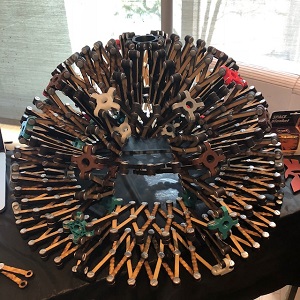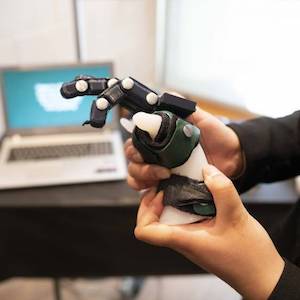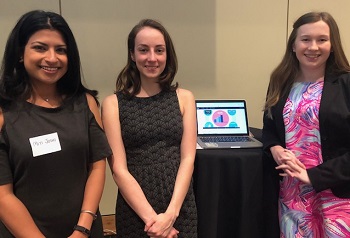Design Day 2019 took students and visitors to Mars, a diving depth of 300 feet and a potential green oasis above a stretch of Interstate 65.

Other projects included a robotic device for a young boy born with a partial right hand, an easily customized ultrasound brain helmet, an affordable 3D-printed canine prosthetic, advanced lab equipment, a water treatment system for a Guatemalan village and apps that assist genetic counselors, connect lawyers to clients in Syria, evaluate air quality and use machine learning to investigate police response times.
“This is the best day of the academic year for me,” Philippe Fauchet, Bruce and Bridgitt Evans Dean of Engineering, told the crowd.Inspiration and innovation abounded as more than 70 teams of senior engineering students presented their final projects Monday. The annual event attracted hundreds of visitors from Vanderbilt and the Nashville community to the Student Life Center.
500 days on Mars
Katie Nachtsheim and four other mechanical engineering majors took on a NASA-sponsored project to design a habitat to sustain five astronauts on Mars for 500 days. In working on concepts, Nachtsheim said she was inspired by a favorite childhood toy – a Hoberman sphere. The sphere resembles a geodesic dome but collapses to a fraction of its size.

The habitat, which would fit into a standard payload fairing, meets NASA-3001 technical specifications for human needs and safety. The design involves three domes connected by telescoping hallways. The largest dome, roughly 79 feet in diameter, is a three-tiered living area with communal space, kitchen, bedrooms and bathrooms, plus exercise area and controls areas. The two smaller domes, about 30 feet wide, house a medical facility and a research lab.
“I had that toy growing up,” Nachtsheim said. “I just always remember having it.”
She and teammates Elias Germanakos, Vid Lutz Jr., Samantha Majumder and Harrison Vanderwort worked with an aerospace engineer and concept designer from NASA Marshall Space Flight Center.
NASA was among dozens of government agencies, small companies and household names that sponsored projects and provided advisers. The rigorous two-semester requirement provides students with experience working with design constraints, budgets, reviews and deadlines.
Other sponsors included the Nashville Civic Design Center, Inventiv Tools, FedEx Express Nissan North America, Siemens, Metova, DENSO, NASA’s Marshall Space Flight Center and NAVSEA. Multiple Vanderbilt and Vanderbilt University Medical Center departments also sponsored projects and provided advisers.

A new grasp on life
Among them was Gage, age 9, was born with a right hand with only a thumb and little finger.
A four-student team of mechanical engineering seniors went through multiple iterations to design and build a partial prosthetic hand that can easily be scaled up as he grows.
The team of Lin Liu, Kimberly Majumder, Lauren Saxon and Harrison Yan used 3D-printing and molded thermoplastic to create and lightweight, durable device that allows Gage to pick up items such as a screwdriver.
Passively activated by Gage’s own wrist, the prosthesis did fall short on one minor client request. Gage had asked for camouflage patterned coloring but, Majumder said, the team had to settle for olive green thermoplastic.
A green canopy for I-65 stretch
Three civil engineering majors worked with non-profit and professional urban planners on a design and feasibility study of “capping” 3,500 feet above Interstate 65 from Church Street in downtown Nashville to 12th Avenue South. The ambitious plan would create 14 acres of parks with pedestrian and bicycle paths and add to the city’s tree canopy.
The estimated cost? A cool $234 million. The team of Claire Chandler, Hunter Conti and Ian Faucher studied similar projects in four U.S. cities: Dallas, 5.2 acres total, completed in 2012; Pittsburgh, 3 acres, under construction now; Philadelphia, 12 acres including a civic facility, funded and in the design phase; and Atlanta, 9 acres and unfunded but in preliminary design phase.
After considering potential issues with utilities, communications infrastructure and traffic patterns the team found “no fatal flaw” with pursuing the idea for Nashville. The Nashville Civic Design Center sponsored the project; the organization plus Barge Design Solutions and the Greater Nashville Regional Council provided advisers.
STEM concepts and boy bands
The “boy band” is a pop culture standard. The computer science team of Tessa Jensen, Miti Joshi and Catherine Lambert applied machine learning to this phenomenon to predict what factors drove success. The idea is to use a fun and accessible topic to introduce younger students to machine learning and demonstrate how they work.

The team settled on 16 indicators – from the key of a hit song to the age of band members when the ensemble began to whether a lead singer played an instrument – and a data set of 110 bands over the last 70 years.
For comparison, they used different approaches to train a neural network – a random classifier, Naive Bayes, classic KNN classifier, KNN Manhattan distance classifier, and a decision tree classifier among them. A data set of 110 is very small for machine learning purposes and affected the results, the students said. Nonetheless, pop music fans and computer science professionals take note: KNN Manhattan performed the best.
